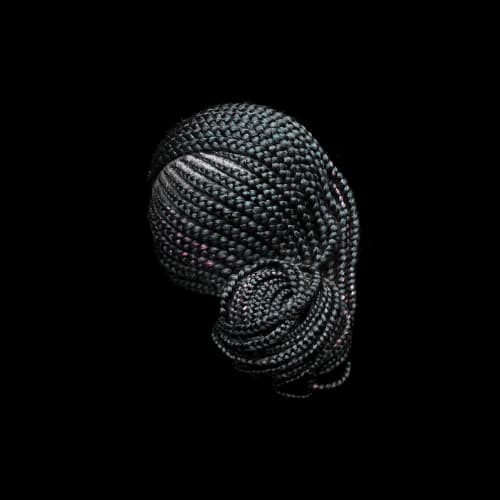Pierre-François Ouellette art contemporain is proud to present Chains & Crowns, Stephane Alexis' first solo exhibition in Montreal.
"Good hair or bad hair I. On the surface, this may seem to be a simple, even superficial, concern—no matter who or how old you are, or where you come from, what you see in the mirror and how you present yourself (and hair is an undeniably large part of that) is more often than not a routine beginning to the practical demands of everyday life. Yet the more you think about it, the more complex this particular notion of "good" or "bad" becomes. Hair is an outward signal of inward perception that, depending on your perspective and priorities, can be a significant factor for self-confidence, personal wellbeing, social status, political choice, and professional success. How we project these factors on any given day, whether cleanly coiffed or punk dishevelled, is largely determined by an underlying style book of aspirational cues and codes driven as much by the image factory of fashion magazines and social media as by the profit margins of the corporate beauty industry. Like it or not, good or bad hair is more complicated than it looks.
Good hair or bad hair II. In their landmark study, Hair Story: Untangling the Roots of Black Hair in America, authors Ayana D. Byrd and Lori L. Tharps trace the cultural, commercial, and political histories of Black hair from 15th century Africa and the gross trauma of the Middle Passage through the sinister indignities of slavery and Jim Crow to the radical refusals of the Civil Rights Movement, Black Power, and its varying (and at times, conflicting) echoes into the 21st century. Consistent throughout for Byrd and Tharps is how deep-set the fundamental realities and imposed Eurocentric value systems of this good or bad hair binary have been and continue to be for Black Americans (and Black women and men anywhere, for that matter). In many ways, it's an ongoing story of conformity and resistance, of subjugation and pride, of the politics of appearance and affirmations of difference—always as a matter of survival. But it's also a story of innovation (the first female self-made millionaire in the US was Black hair-care entrepreneur Madame C.J. Walker), appropriation (including the controversy over Bo Derek "popularizing" beaded cornrows in the film 10), and, perhaps most of all, community, where hours regularly spent in beauty salons, barber shops, or neighbourhood kitchens provided rare safety to share generational knowledge and strengthen resilience.
Good or bad hair III. Overcoming adversity and the healing power of shared cultural experience is central to Ottawa artist Stephane Alexis's photo series Chains & Crowns. Each image in the series (including some shot in an ad hoc studio in the back of a local beauty salon) depicts a different Black hairstyle—Fishtale Cornrows, Box Braids, Senegalese Twists, Bantu Knots, High Cut Fades, Afros—which Alexis has then digitally refined and selectively highlighted with an aura of subtle colour determined in conversation with his sitters. It's a serial portrait of how identity is perceived, created, and framed. The intricate lines, weaves, and shapes of each hairstyle, often requiring hours of expertise to achieve and maintain, resolve as unique sculptural geometries—a reverential index of form, labour, and beauty. Most telling, though, is Alexis's decision to photograph only the backs of his sitters' heads, which float isolated on fathomless black backgrounds. This is in part, he says, based on the innocent confusion he felt as the only Black student in his grade school class and being asked by classmates if they could touch his hair. It's an experience familiar to many that once again reveals the long and persistent legacy of an essentially dehumanized Black identity. But for Alexis, this reality also presents an opportunity independent of culture or race that is embodied in his photographs—to celebrate the beauty of difference, to unlearn hard-wired distinctions between "good" and "bad," and to find a common ground where the traumas of the past have the potential to inform a more hopeful present and future. -Bryne McLaughlin" March 2022
Chains & Crowns (2020)
This work celebrates the heritage of black communities through their hair. While beauty standards still consider frizzy hair dirty and ugly, thus pushing black people to straighten their hair with ammonia or formaldehyde products, the appropriation of African hairstyles, and particularly braids, has been perpetuated since the dawn of time. Inspired by the hair journey of the artist’s mother, this photographic project traces the different hairstyles invented by black people, symbols of their creativity, resistance and resilience. The artist wishes to question the history of our nappy era (contemporary movement of valorization of natural frizzy hair), and therefore create a dialogue. How to identify the importance of hairstyles in black cultures, remedy the violence of cultural appropriation and reaffirm the dignity of black communities?
Stephane Alexis's work emanates from his personal experiences with the demographic and sub-demographic segments to which he belongs. Through a differentiated lens, Alexis magnifies the resilience and dignity of his communities and engages the Other to question his own knowledge and awareness.
From the exploration of masculinity to the issues of the African-Canadian community, from the world of people with special needs to family caregivers, Alexis conducts a great deal of research drawing from both his own experience and external sources to guide him in the direction of each project.
Through the plastic and conceptual qualities of his photographic work, Alexis wishes to build a bridge towards a better understanding of the situations and issues facing his communities.